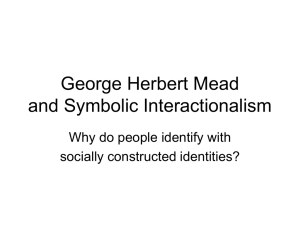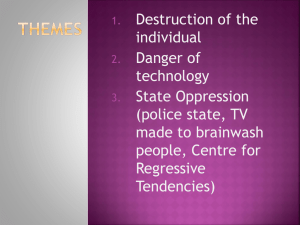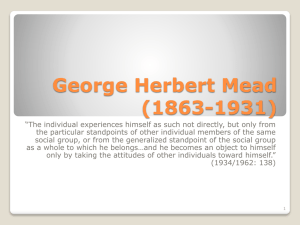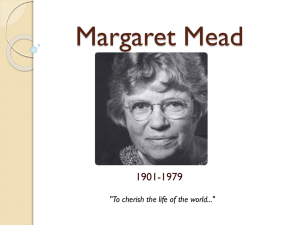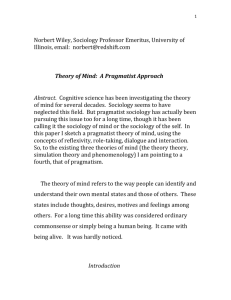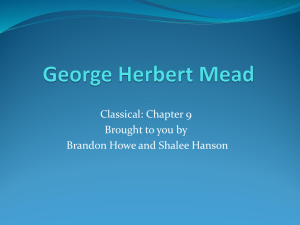Chapter 7
advertisement
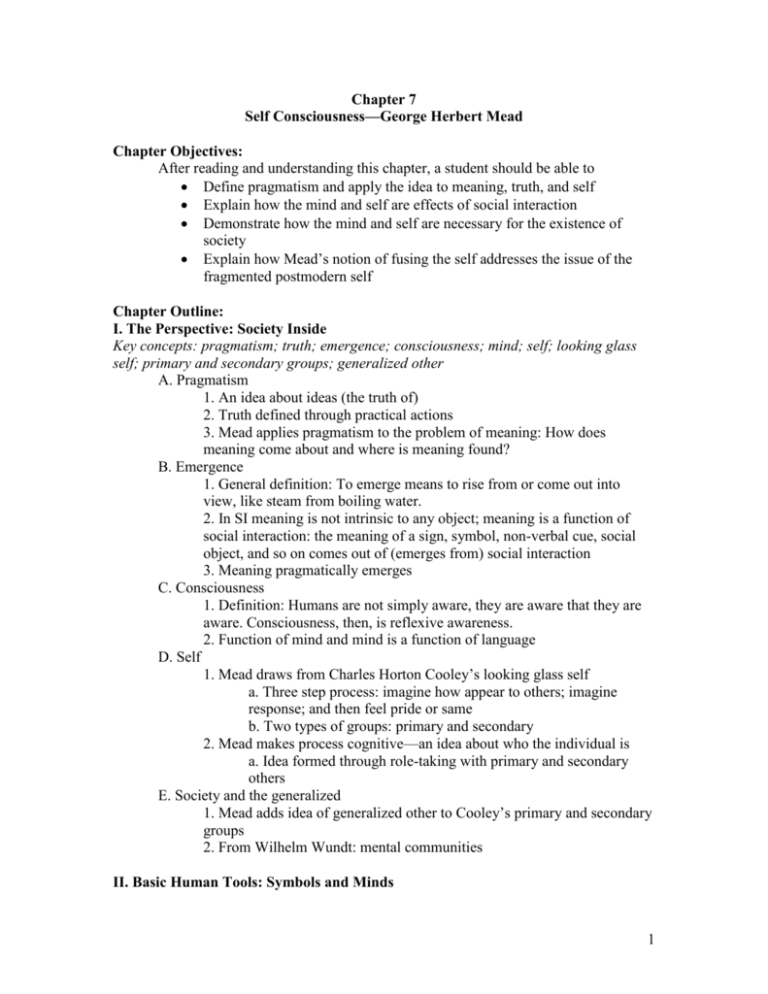
Chapter 7 Self Consciousness—George Herbert Mead Chapter Objectives: After reading and understanding this chapter, a student should be able to Define pragmatism and apply the idea to meaning, truth, and self Explain how the mind and self are effects of social interaction Demonstrate how the mind and self are necessary for the existence of society Explain how Mead’s notion of fusing the self addresses the issue of the fragmented postmodern self Chapter Outline: I. The Perspective: Society Inside Key concepts: pragmatism; truth; emergence; consciousness; mind; self; looking glass self; primary and secondary groups; generalized other A. Pragmatism 1. An idea about ideas (the truth of) 2. Truth defined through practical actions 3. Mead applies pragmatism to the problem of meaning: How does meaning come about and where is meaning found? B. Emergence 1. General definition: To emerge means to rise from or come out into view, like steam from boiling water. 2. In SI meaning is not intrinsic to any object; meaning is a function of social interaction: the meaning of a sign, symbol, non-verbal cue, social object, and so on comes out of (emerges from) social interaction 3. Meaning pragmatically emerges C. Consciousness 1. Definition: Humans are not simply aware, they are aware that they are aware. Consciousness, then, is reflexive awareness. 2. Function of mind and mind is a function of language D. Self 1. Mead draws from Charles Horton Cooley’s looking glass self a. Three step process: imagine how appear to others; imagine response; and then feel pride or same b. Two types of groups: primary and secondary 2. Mead makes process cognitive—an idea about who the individual is a. Idea formed through role-taking with primary and secondary others E. Society and the generalized 1. Mead adds idea of generalized other to Cooley’s primary and secondary groups 2. From Wilhelm Wundt: mental communities II. Basic Human Tools: Symbols and Minds 1 Key concepts: symbols; natural signs; significant gestures; language; mind; reflexiveness A. Symbols 1. Compared to natural signs: a. Natural relationship to object signed b. Private and learned by individual organism 2. Significant gestures/signs a. Reflexive, abstract, and arbitrary b. Charles S. Peirce: the signifier, the signified, and the meaning c. Social objects: anything that can be named in interaction and have legitimate lines of behavior to it d. Language: collection of symbols and social objects i. Repository of social experiences ii. Transcends the here and now B. Minds 1. Based on language 2. Behavior not entity—five behaviors: a. The mind has the ability to use symbols to denote objects, b. To use symbols as its own stimulus (it can talk to itself), c. To read and interpret another's gestures and use them as further stimuli, d. To suspend response (not act out of impulse), e. And to imaginatively rehearse one's own behaviors before actually behaving. 3. Making the mind a. Preconditions: Society, language, interaction (infant dependency) III. Living Outside the Moment—The Self Key concepts: self; I and Me; role-taking; impression management; preparatory stage; play stage; game stage; generalized other stage; abstract thinking A. Defining the self 1. Social object (existing outside of direct experience) 2. A symbolic platform in which to stand and view our own behaviors as if someone else were performing them 3. Reflexive dialog B. Forming the self 1. Primary mechanism: role-taking 2. Stages of self formation a. Preparatory stage (language acquisition and formation of mind) b. Play stage: the child literally takes on the role of one significant other and acts and feels toward her self as the other does c. Game stage: time when children are able to take the role of multiple others separately and can understand rule-based behavior d. Generalized other stage: stage in which the child can place him or herself in a collective role from which to view her own 2 behaviors. It is the time when the self is fully formed as the person takes all of society inside. C. The I and the Me 1. Two sides of self conversations 2. “I” is the seat of impulse 3. “Me” the self as social object formed through role-taking IV. The Emergent Big Brother Key concepts: the act; interaction; institutions; definition of the situation; society; A. The act 1. Because of meaning, humans can act rather than react 2. Four phases of the act: a. Impulse b. Perception (recognition of the pertinent symbolic elements (such as other people, absent reference groups (generalized others) and so on) as well as alternatives to satisfying the impulse) c. Manipulation: takes place in the mind and considers the possible ramifications for self and society of using different behaviors to satisfy the impulse (the all-important pause before action; this is where society becomes possible) d. Consumption: the act B. Interaction 1. Triadic relation: cue, response to cue, and response to response (meaning emerges) 2. Never ending process C. Emerging society 1. Institutions: organization of attitudes carried by social members (generalized other) 2. Definition of the situation: primary meaning given to a social interaction, implicitly contains identities and scripts for behavior 3. Society: an emergent phenomenon that consists of sets of attitudes and legitimated behaviors that people may or may not use in any specific interaction V. Thinking About Modernity and Postmodernity Key concepts: media images; multiphernia; reflexivity; fusing the I and Me; flow A. Reflexivity and the fragmenting of the self 1. Mead’s theory: self a result of role-taking in social interaction; the self becomes unified through generalized other 2. Postmodern problem for the self: possibility that the generalized other is no longer cohesive or collectively held a. Postmodern self created through role-taking with media images that have no social cohesion (multiphernia) b. Radical reflexivity B. Fusing the I and Me 1. Possible reason why postmodern self isn’t as fragmented as supposed 3 2. Self fused = dampening or loss of reflexivity 3. Two types of practices a. Ritual b. Flow Chapter Summary: To think like Mead is to see that mind, self, and society are on-going social productions that emerge from interactions. There are basic elements, or tools, that go into making us human. Among the most important of these are symbolic meaning and the mind. We use symbols and social objects to denote and manipulate the environment. Each symbol or social object is understood in terms of legitimated behaviors and pragmatic motives. The mind uses symbolic-social objects in order to block initial responses and consider alternative lines of behavior. The mind is thus necessary for society to exist. The mind is formed in childhood through forced social interaction. The self is a perspective from which to view our own behaviors. This perspective is formed through successive stages of role-taking and becomes a social object for our own thoughts. The self has a dynamic quality as well—it is the internalized conversation between the I and the Me. The Me is the social object, and the I is the seat of the impulses. When the self is able to role-take with generalized others, society can exist as well as an integrated self. Role-taking with generalized others also allows us to think in abstract terms. Society emerges through social interaction; it is not a determinative structure. In general, humans act more than react. Action is predicated on the ability of the mind to delay response and consider alternative lines of behavior with respect to the social environment and a pertinent self. Thus mind, self, and society mutually constitute one another. Interaction is the process of knitting together different lines of action. Meaning is produced in interaction through the triadic relation of cue, response, and response to response. What we mean by society emerges from this negotiated meaning as interactants role-take within specific definitions of the situation and organized attitudes (institutions). Mead’s theory along with postmodern theory implies that the self can become fragmented through role-taking with multiple and disconnected images and through radical reflexivity. An extension of Mead’s theory indicates that a sense of core self can be produced through the practice of Durkheimian rituals and intense personal experiences. In such experiences, the I and the Me fuse, reflexivity is dampened, and the self is experienced as essentially real. 4
